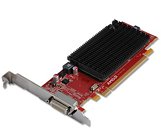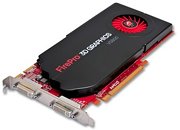- Joined
- Oct 9, 2007
- Messages
- 47,670 (7.43/day)
- Location
- Dublin, Ireland
| System Name | RBMK-1000 |
|---|---|
| Processor | AMD Ryzen 7 5700G |
| Motherboard | Gigabyte B550 AORUS Elite V2 |
| Cooling | DeepCool Gammax L240 V2 |
| Memory | 2x 16GB DDR4-3200 |
| Video Card(s) | Galax RTX 4070 Ti EX |
| Storage | Samsung 990 1TB |
| Display(s) | BenQ 1440p 60 Hz 27-inch |
| Case | Corsair Carbide 100R |
| Audio Device(s) | ASUS SupremeFX S1220A |
| Power Supply | Cooler Master MWE Gold 650W |
| Mouse | ASUS ROG Strix Impact |
| Keyboard | Gamdias Hermes E2 |
| Software | Windows 11 Pro |
AMD today introduced the AMD FirePro 2270 and ATI FirePro V5800 DVI professional graphics cards. AMD designed these new offerings for professionals in the medical, financial, design and engineering fields who require the ability to view and interact with multiple applications simultaneously.
"Because of their superior power consumption and multi-display capabilities, solutions based on the AMD FirePro 2270 and ATI FirePro V5800 DVI deliver strong value for financial, medical and corporate workstation environments," said Janet Matsuda, general manager, AMD Professional Graphics. "With the AMD FirePro family, we continue to demonstrate our focus on enhancing productivity through an enhanced visual experience."


As AMD's only low-profile, passively cooled, dual-display, triple set support solution graphics card, the AMD FirePro 2270 delivers multi-display capabilities for increased efficiency, longevity and compatibility. For example, the AMD FirePro 2270 features a fan-less, energy efficient design that consumes 15 watts maximum power and less than 10 watts on average. Additionally, the AMD FirePro 2270 enables efficient multitasking across multiple applications, including graphics intensive applications, helping to prevent system slowdowns. Legacy support for DisplayPort, DVI and VGA connectivity allows for seamless integration into existing installations.
The ATI FirePro V5800 DVI delivers professionals the graphics performance needed to drive two high-resolution dual link DVI displays while offering users the ability to stretch one image or application across both screens for expanded field of view and enhanced productivity. Support for DVI, the most common digital interface, makes setting up dual-display configurations easier than ever. The ATI FirePro V5800 DVI professional graphics delivers a full 30-bit display pipeline to enable increased color reproduction and superb visual fidelity and supports packed pixel mode to support dual 5MP medical displays.
With AMD FirePro 2270 starting at $149 US SEP and ATI FirePro V5800 DVI starting at $469 US SEP, both cards are available from professional graphics retailers worldwide.
For more information, visit the product pages of FirePro 2270 and FirePro V5800 DVI.
View at TechPowerUp Main Site
"Because of their superior power consumption and multi-display capabilities, solutions based on the AMD FirePro 2270 and ATI FirePro V5800 DVI deliver strong value for financial, medical and corporate workstation environments," said Janet Matsuda, general manager, AMD Professional Graphics. "With the AMD FirePro family, we continue to demonstrate our focus on enhancing productivity through an enhanced visual experience."


As AMD's only low-profile, passively cooled, dual-display, triple set support solution graphics card, the AMD FirePro 2270 delivers multi-display capabilities for increased efficiency, longevity and compatibility. For example, the AMD FirePro 2270 features a fan-less, energy efficient design that consumes 15 watts maximum power and less than 10 watts on average. Additionally, the AMD FirePro 2270 enables efficient multitasking across multiple applications, including graphics intensive applications, helping to prevent system slowdowns. Legacy support for DisplayPort, DVI and VGA connectivity allows for seamless integration into existing installations.
The ATI FirePro V5800 DVI delivers professionals the graphics performance needed to drive two high-resolution dual link DVI displays while offering users the ability to stretch one image or application across both screens for expanded field of view and enhanced productivity. Support for DVI, the most common digital interface, makes setting up dual-display configurations easier than ever. The ATI FirePro V5800 DVI professional graphics delivers a full 30-bit display pipeline to enable increased color reproduction and superb visual fidelity and supports packed pixel mode to support dual 5MP medical displays.
With AMD FirePro 2270 starting at $149 US SEP and ATI FirePro V5800 DVI starting at $469 US SEP, both cards are available from professional graphics retailers worldwide.
For more information, visit the product pages of FirePro 2270 and FirePro V5800 DVI.
View at TechPowerUp Main Site


